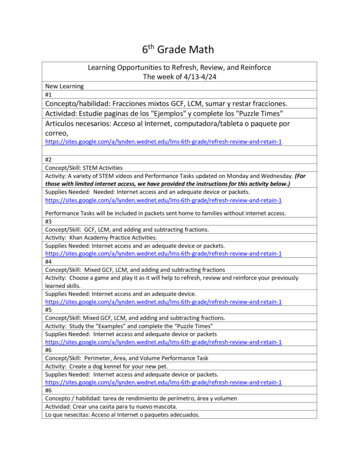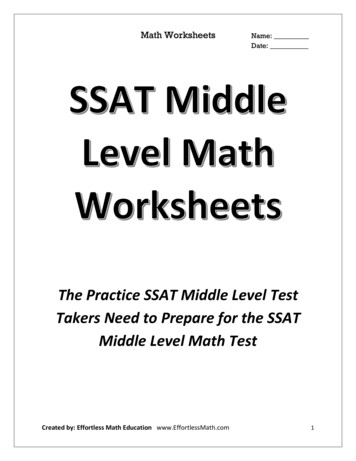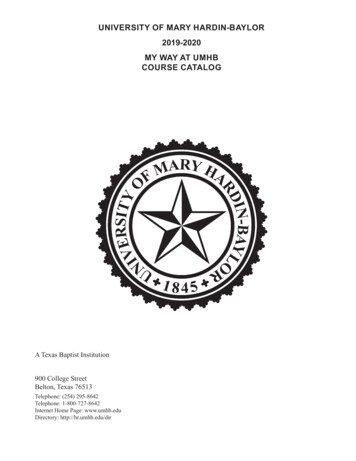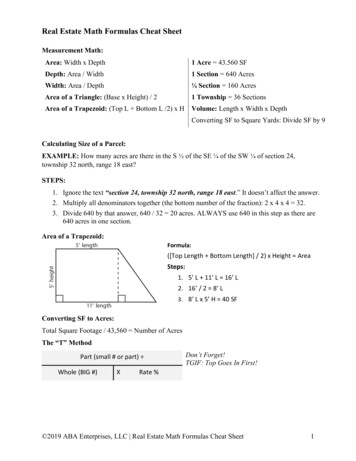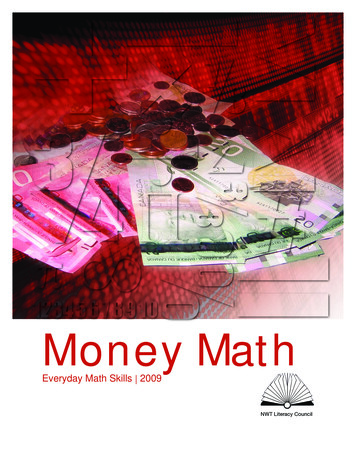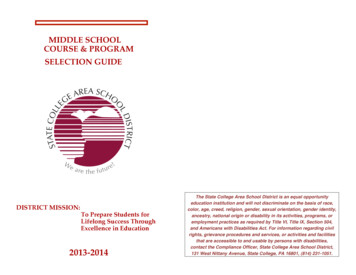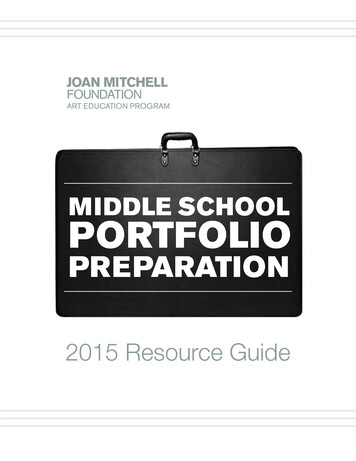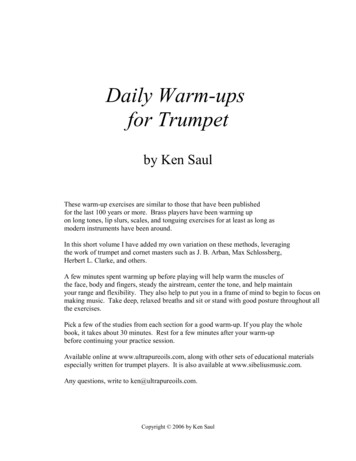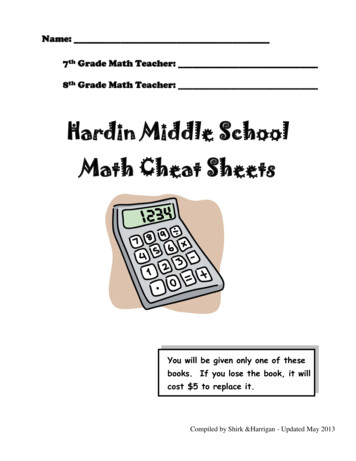
Transcription
Name:7th Grade Math Teacher:8th Grade Math Teacher:Hardin Middle SchoolMath Cheat SheetsYou will be given only one of thesebooks. If you lose the book, it willcost 5 to replace it.Compiled by Shirk &Harrigan - Updated May 2013
Alphabetized TopicsPages3232 AreaCircumference Comparing23, 26 Proportions Congruent Figures35 PythagoreanTheorem36 Converting R.A.C.E.41 Divisibility Rules Range11 Equations14, 15,23837, 38,39 Rates25 Flow Charts Ratios25, 26 Formulas Rounding10 Fractions Scale Factor35 Geometric FiguresGreatest CommonFactor (GF or GCD)InequalitiesIntegersLadder MethodLeast CommonMultiple(LCM or LCD)MeanMedianModeMultiplication TableOrder ofOperations Similar Figures3522 Slide Method224018, 1922 SubstitutionSurface AreaSymbols2933522 Triangles30, 361111116 VariablesVocabulary WordsVolumeWord Problems29433441, 42 Percent Perimeter32, 33,3418, 19,20, 21,22, 23,2430, 3116, 1723, 24,25, 2632 Place ValuePropertiesPages9, 101222, 23,24, 25,26
Table of ContentsPagesCheat Sheets5 – 425678910111213141516 – 1718 – 1920 – 2122 Math SymbolsMultiplication TableTypes of NumbersDivisibility RulesPlace ValueRounding & ComparingMeasures of Central TendencyPropertiesCoordinate GraphingMeasurement ConversionsMetric ConversionsOrder of OperationsIntegersFraction OperationsLadder/Slide MethodConverting Fractions, Decimals, &PercentsCross ProductsRatios, Rates, & ProportionsComparing with Ratios, Percents,and ProportionsSolving Percent ProblemsSubstitution & VariablesGeometric FiguresArea, Perimeter, CircumferenceSurface AreaVolumeCongruent & Similar FiguresPythagorean TheoremHands-On-EquationUnderstanding Flow Charts Solving Equations Mathematically39 InequalitiesR.A.C.E. – Answering QuestionsWord Problem Cheat Sheet404142 Math Vocabulary2324252627 – 282930 – 313233343536373843 - End3
4
Mathematic Symbols Cheat Sheet Plus or PositiveLine AS–Minus or NegativeLine segment AS * /xMultiplied byRay ASDivided byTriangle ABC Equal toAngle ABC NOT equalAngle B Approximately equal toRight angle Congruent toPerpendicular to Is less thanPerpendicular to Is Greater thanIs greater than or equal to Degree%PercentΣSumSquare root of x Is less than or equal toa/b a:b(a, b)Ratio of a to be or adivided by b or thefraction a/bOrdered pairπPi (3.14.159)!FactorialxnNth power of xInfinity5
6
Types of Numbers – Cheat SheetPrime Number – A number that has exactlytwo (2) factors Zero (0) and One (1) are neither primenor composite because they only haveone factor (itself)Composite Number – A number that hasthree (3) or more factorsEven Numbers ending in 0, 2, 4, 6, 8Odd Numbers ending in 1, 3, 5, 7, or 97
Divisibility Rules- Divisible by 2 – All even numbers are divisible by 2. Even numbersend in 0, 2, 4, 6, or 8 and all are divisible by 2.- Divisible by 3 – If the sum of the digits is divisible by 3 so is thenumber. Add up the digits in the number, if the answer is divisibleby 3 so is the number.- Divisible by 4 – Odd numbers are NEVER divisible by 4. Oddnumbers end in 1, 3, 5, 7, or 9, so any number ending with one ofthis will NOT be divisible by 4.Even numbers MAY be divisible by 4. To check, look at the last 2digits of the number. If the number formed by the last 2 digits isdivisible by 4, then the number is divisible by 4.- Divisible by 5 – If a number ends in a 5 or a zero then it isdivisible by 5- Divisible by 6 – If a number is divisible by 2 AND 3, it is divisibleby 6.- Divisible by 9 – – If the sum of the digits is divisible by 9 so is thenumber. Add up the digits in the number, if the answer is divisibleby 9 so is the number.- Divisible by 10 – Numbers that are divisible by 10 end in with azero.8
Place Value Cheat SheetFrom Billions to Ten-millionths9
Place Value & RoundingComparing & Ordering DecimalsRounding RulesExampleExample1. Underline the determined value2. Draw an arrow to number to the right of underlinednumber3. 0 – 4 Round Down (Keep the underline number thesame)a. All numbers to the left of underlined numberstay the sameb. Underlined number stays the samec. All numbers to the right of underlined numbergo to zero4. 5 – 9 Round Up (Underline number goes up 1)a. All numbers to the left of the underline numberstay the sameb. Underline number goes up 1c. All numbers to the right of underlined numbergo to zeroComparing Decimal Rules1. Line up the decimals using their decimal point2. Fill in zeros so that all numbers have the sameplace value3. Compare each number in their “lanes” (from left toright)4. Determine greatest to least or least to greatest42.342.3576.8576.8Round DownRound Up42.3 42.0576.8 580.0BillionsMillionsThousand** If you do not see a decimalpoint, it is at the end of thenumberExample 423 onsHundred-MillionsBillionsTen-BillionsHundred Billion.10Decimals
Measures of Central Tendency:The Mean, Median, Mode, and RangeWhen finding the measures of central tendency the first step is to place thenumbers in order from least to greatest.Mean (Average): Add up a list of values in a set of data and divide by the number of values you have.6, 4, 4, 3, 8Step 1Step 2Step 3AnswerPut in order from least to greatestAdd up all the numbersDivide by the number of values you have3, 4, 4, 6, 83 4 4 6 8 2525 5 5The mean is 5Median (Middle): The middle value in a set of data when the values are written in order. If there are 2values in the middle, find the mean of the two.6, 4, 4, 3, 8Step 1Step 2Put in order from least to greatestFind the middle number**If there are an odd number of data valuesAnswerStep 1Step 2Step 33, 4, 4, 6, 83, 4, 4, 6, 8The median is 46, 4, 4, 3, 8, 5Put in order from least to greatestFind the middle number**If there are an even number of data values then there willbe two middle numbersFind the mean of the two middle numbersAnswer3, 4, 4, 5, 6, 83, 4, 4, 5, 6, 84 5 99 2 4.5Median 4.5Mode (MOST): The value in a set of data that is repeated most often. A set of data could have nomode, one mode, or more than one mode.6, 4, 4, 3, 8Step 1Step 2AnswerPut in order from least to greatestFind the number that occurs most often3, 4, 4, 6, 83, 4, 4, 6, 8The mode is 4Range: The largest number minus the smallest number6, 4, 4, 3, 8Step 1Step 2AnswerPut in order from least to greatestSubtract the largest number minus the smallest number113, 4, 4, 6, 88-3The Range 5
Properties1. Commutative Property Numbers can be added or multiplied in any order and the answer is still the same.Examples:Commutative Property of Addition:Commutative Property of Multiplication:3 2 2 35(4) 4(5)a b b aab ba2. Associative Property When adding OR multiplying 3 or more numbers, they can be grouped in any wayand the answer remains the same.Examples:Associative Property of Addition: (2 4) 9 2 (4 9)Associative Property of Multiplication: (5x4)x2 5x(4x2)a (b c) (a b) c(cd)e c(de)3. Identity Property of Addition When you add 0 to any number your answer is that number.Examples: 5 0 50 1,253 1,253a 0 a0 b b4. Identity Property of Multiplication When you multiply any number by 1 your answer is that number.Examples: 4 1 41 x 746 7461xa ab x 1 ba 0 00xb 05. Property of Zero Any number multiplied by zero is zero.Examples: 0 x 8 052 0 06. Distributive Property Multiplying a sum by a number is the same as multiplying each addendby the number and then adding the products.Examples:2(3 4) 2 3 2 4a x (b c) (a x b) (a x c)12
Coordinate Plane Cheat SheetThis is a coordinate plane. Sometimes it isreferred to as a coordinate graph. It hastwo axes and four quadrants. The twonumber lines form the axes. The horizontalnumber line is called the x-axis () andthe vertical number line is called they-axis ( ).The coordinate plane is divided into 4 partcalled quadrants. See the figure to the rightto see the location and name of eachquadrant.You can describe points on this graph byusing a coordinate pair. A coordinate pairhas an x-coordinate and a y-coordinateand looks like this: (x, y). The center of thecoordinate plane is called the origin.The origin has coordinates of (0, 0).Locating Points on a Coordinate GraphLocating points on a coordinate graph is very similar to playing the game Battle Ships.The coordinates tell you exactly where the point will be located. The x- andy-coordinates in the coordinate pair tell you which way to go and how far to go.Follow the steps below:It takes 2 moves to plot a point.1.) Start at the origin2.) The x-coordinate comes first and itmoves to the right or left. Right forpositive numbers and left for negative.Example: (-3, 5)For the 1st move, the x-coordinate is -3so starting at the origin, move 3 places tothe left.3.) The y-coordinate comes last & it movesup or down. Up for positive numbers anddown for negative.Example: (-3, 5)You have already moved to the left 3places, and for the 2nd move go up 5.13
Measurement Conversion14
Metric ConversionKing Henry Died By Drinking Chocolate MilkKing Henry Doesn’t Usually Drink Chocolate MilkExampleConvertCompare15
Order of Operations Cheat SheetThere is a specific order in which math problems should be worked out. It is called the “order of operations.” If youdo not work math problems in the correct order, you probably will get the wrong answer. It is like a step-by-steprecipe to work out a math problem that will lead you to the correct answer.1stParenthesis & Grouping Symbols –2ndExponents –3rdMultiply or Divide –4thAdd or SubtractHint: Please guys, excuse my dear Aunt SalllyExamples::Parenthesis: (6 7)PParenthesis1stDo the parenthesisand all other groupingsymbols.GGrouping symbolssuch as bracketsor a fractionbar.EExponentsMMultiplyDDivideMultiply or dividefrom LEFT TORIGHTAAdd4thSSubtractBrackets: [(3 2) – (2-1)]Brackets usually go around a set of parenthesis. Work inside thebrackets first until there is nothing left to do.Fraction Bars: Do everything above the fraction bar, then everything below theFraction bar, and then divide.2ndDo all exponents.3rd23 2·2·2 842 4(4) 16Sometimes you multiply first, but sometimes you divide first. Youdecide by going left to right.6·2 418 3·5Multiplying comes3 4Dividing comes6 · 5first12first30Sometimes you add first, but sometimes you subtract first. YouAdd or subtract fromdecide by going left to right.LEFT to RIGHT4 2 – 57 – 3 3Adding comes6 – 5Subtracting comes4 3first1first716
Examples of using the proper order of operations:Example 1:Example 2:3(17 3) 2 4 2(17 3) 23 4 220 23 4 220 8 4 220 2 220 424st12nd3rd4th5th2[6 (4 – 3)] – 52[6 (4 – 3)] – 52[6 1] – 52[7] – 514 – 5– parenthesis– exponents– divide- multiply– add93 – 3 100 100AnswerExample 4:– 3 10– 3 10– inner parenthesis– brackets– multiply- subtractAnswerExample 3:- 3 101st2nd3rd4th1st – grouping symbols33 – 233 – 21st – grouping symbols 22nd – divide(above & below fraction bar)2nd3rd33 –– divide– subtract4th – add3rd – exponent27 – 5 24th – subtract2417(finish the grouping symbol )33 - 5 222 2Answer(above & below fraction bar)(because it comes first)5th - addAnswer
IntegersADDING INTEGERSChip Board1. Set up chipboard by putting chips on theNumber Line1. Find starting pointchip board for the first part of the problem– Remember black chips are positive and red 2. ADDING mean you’ll MOVE to theare negative.RIGHT.2. Add more chips to the chip board from thesecond part of the problem3. Calculate the value of the chip boardREMEMBER:-Pair up the black and red chips.One black chip & one red chip equalzero.Remove each pair from the boardThe final value is represented by what isleft on the board.3. If you come to a NEGATIVE SIGNin the problem, you must CHANGEDIRECTIONS.Move and see where you land, that isyour answer.Rules1. Positive Positive Positive Just add Answer is positive2. Negative Negative Negative Ignore the signs & just addAnswer is negative3. Negative Positive Neg. or Pos.Positive Negative Neg. or Pos. 18Ignore signs & subtractIf you have more negatives, theanswer is negativeIf you have more positives, theanswer is positive.
SUBTRACTING INTEGERSRules1. Rewrite the subtraction problem as anaddition problem. Subtracting a number is the sameas adding it’s opposite.2. Now just follow the rules for addingintegersis the same as 7 (-5) Subtracting 5 is the same as adding itsopposite (-5). Now just add.****************-6 – (-3) is the same as -6 3 Subtracting -3 is the same as adding itsopposite (3). Now just add.1. Find starting point2. Then just follow the rules2. SUBTRACTINGthe sign.for adding integers.Examples:change the sign. You get:6 -2 Now follow the rule for adding,************************-8 – (-5) Cross the line &change the sign. You get:-8 ( 5) Now follow the rule for adding.****************-2 – 9 is the same as -2 (-9) Subtracting 9 is the same as adding itsopposite (-9). Now just add.mean you’ll MOVE tothe LEFT.3. If you come to aNEGATIVE SIGN inthe problem, youmust CHANGEDIRECTIONS.4. Move and see whereyou land, that is youranswer.************************-4 – 7 Cross the line andchange the sign. You get:Number Line #21. Subtraction means you arefinding a “difference”. “Difference” basically meansthat you need to find outhow far apart the numbersare from each other.2. Put both numbers on thenumber line and see howmany far apart they are.3. Now you must determinewhether you answer ispositive or negative. A large number minus asmaller number has apositive answer. A small number minus alarger number has anegative answer.Large – Small Positive-4 -7 Follow rules; add.Small – Large NegativeDividing IntegersMultiplying Integers Number Line #11. Cross the line then change6 – 2 Cross the line andExamples:7–5 Easy Method Positive x Positive PositiveNegative x Negative PositivePositive x Negative NegativeNegative x Positive Negative19Positive Positive PositiveNegative Negative PositivePositive Negative NegativeNegative Positive Negative
Fraction OperationsAdding & Subtracting Fractions1. Make sure the denominators are the same.2. If needed, we have to build each fraction sothat the denominators are the same.3. Then, we add or subtract the numerators.4. The denominator of your answer will be thesame denominator of the built-up fractions.5. Reduce or simplify the answer, if required.Examples: To add or subtract fractions with acommon denominator, you simply omit Step#1.1/3 1/3 2/3Note: DO NOT add or subtract denominators!When adding fractions with differentdenominators, we do all the steps.1/2 1/33/6 2/6 5/6Multiplying FractionsHere are the Rules for multiplying fractions.1. You do not have to worry about a commondenominator!2. If possible, simplify before you multiply.3. Multiply the numerators.4. Multiply the denominators.5. Simplify or reduce the resulting fraction, ifpossible.Examples:248x 3515Remember: You do not have to worry about acommon denominator! Just multiply thenumerators & then multiply the denominators!!Multiplying Mixed Numbers1. Change the mixed numbers into improperfraction2. If possible, simplify first.3. Multiply the numerators.4. Multiply the denominators.Examples:113X 2 34Change mixed numbers to improper fractions thensolve.5. If necessary, rewrite your answer as a mixed411X 34number and check to be sure it is in simplestform.2044112 31233
Dividing FractionsA Key Word to UnderstandReciprocalA reciprocal of a number is when the numeratorand denominator switch places.Example:If the fraction is a mixed number, change it to animproper fraction first, then write its reciprocal.The product of any number and its reciprocal isalways one.The reciprocal ofThe reciprocal of34is .4351is .51Example of reciprocal with mixed numbers:321and it’s reciprocal is1 equals232Steps for Dividing Fractions1. Rewrite the division problem as amultiplication problem, but multiply by thereciprocal of the number you were dividing by.2. Simplify before you multiply.3. Multiply the numerators.4. Multiply the denominators.5. Be sure your answer in its simplified orreduced form. Change improper fraction towhole numbers or mixed numbers.Example:11 23Rewrite as a multiplication using the reciprocal.13X21Now solve.13 3X Simplified 1½212Hints for Dividing Mixed Numbers1. Change the mixed numbers into improperfraction2. Rewrite the division problem as amultiplication problem, but multiply by thereciprocal of the number you were dividingby.3. Simplify before you multiply.4. Multiply the numerators.5. Multiply the denominators.6. Be sure your answer in its simplified orreduced form. Change improper fraction towhole numbers or mixed numbers.Example:121 232Rewrite division problem with improper fractions.3 283Now rewrite as a multiplication using thereciprocal, and solve.3221X38 916
Ladder / Slide MethodGreatest Common Factor or Divisor (GCF/GCD):Highest number that divides exactly into two or more numbersLeast Common Denominator or Multiple (LCM or LCD):Smallest number that is a multiple of two or more numbersSmallest Number that is a multiple of two or more denominatorsSimplified Fractions:Reduce a number to make as simple as possible. (Numbers only have a factor ofone that is the same)Step 1:Write the two numbers in a boxStep 2:Find a factor that goes into both numbersStep 3:Divide both numbersContinue this process until both numbers only have a factor of 1 that issimilarStep 4:GCF/GCD Multiply the left sideLCM/LCD Multiply the left side and the bottom numbersSimplifiedBottom numbers become you simplified fractionFractions22
Fractions, Decimals, & PercentsChange a . . .To a . . .To a . . .DecimalPercentFractionDivide the numerator by theChange the fraction to a decimal then multiply thedenominator.Example: ¾ would be 3 4 0.75decimal by 100.Example: ¾ 0.75 Then 0.75 x 100 75%Change a . . .To a . . .To a . . .PercentFractionMultiply the decimal by 100.If you can read the decimal properly you can write itas a fraction. Simplify the fraction.DecimalChange a . . .PercentExample: To change 0.382 to a percent justmultiply by 100.Example: 0.875 reads 875 thousandths – as a fraction that would be87510000.382 x 100 38.2%which reads exactly the same. Now simplify your answer and you are finishedTo a . . .To a . . .DecimalFractionDivide the percent by 100.Write the percent as a fraction over 100 then simplifyExample: 75% would be 75 100 0.75So 75% 0.75875 7 .1000 8the fraction.Example: 75% would be7575. Simplified ¾100100Finding the Percent of a NumberFinding the Fraction of a NumberTo find the percent of a number – Multiply the number by the percentwritten as a decimal or a fraction.Multiply the number by the fraction or if the fraction can be written asa terminating decimal then you can also multiply by the fractionwritten as a decimal.Example: 75% of 40 . 75% 0.75 so this would be0.75 x 40 30 OR since 75% 75 ¾ then ¾ x 40 30.Example: ¾ of 28 would be ¾ x 28 2110023OR0.75 x 28 21
Cross ProductsThe Rule of Cross Products states that when you multiplythe diagonals of 2 fractions they are equal.You can see in the example that 15 x 3 45 and 5 x 9 45or we could say 15 x 3 5 x 9The Rule of Cross Products has truths that are helpful in solving for a missing partof 2 equivalent fractions, ratios or proportions.EXAMPLE:Because of the Rule of Cross Product we know that15n 18 x 10or15n 180.This can be solved algebraically but most prefer the quick and easy way below.QUICK AND EASY SOLUTION24
Ratios Rates & ProportionsRatio: A comparison between two different amounts.There are 3 ways to write ratios8 to 38:3A ratio is usually a part-to-part comparison, but it can be a part to whole comparison.Example: The score was 15 to 4.There are two parts being compared - the score of one team being compared to the score of the otherteam.Proportion: Two ratios that are equal to each other.Example:Proportions are used when two things are being compared and one of the parts is missing.Example: Margaret knows that she can serve 7 people with 2 cans of green beans. She will be feeling 84people at the luncheon. How many cans of green beans will she need to buy?N 24 cansRate: A ratio comparing 2 amounts measured in 2 different units.Example: The ratio below is comparing minutes to kilometers. These are two different units of measurementso this ratio is a rate.Unit Rate: A unit rate is the amount for 1 itemExample:The car gets 32 miles per gallon of gasoline. This is a unit rate because we are talking about 1 gallonof gasolineA proportion can be used to find a unit rate.Example: A bottle of shampoo cost 3.99 for 13.5 ounces. Find the unit rate.N about 0.30 per ounce25
Comparing with Fractions, Percents, Ratios, and ProportionsWhat is being erator partDenominator wholeAlways a part to whole comparisons.The percent is the part out of 100.Example: 53%53 is the part out of 100.The 100 represents the whole.- Most of the time 1 part is being compared to another part- Sometimes 1 part is being compared to the whole- You need to look at what the number represent then think .Are these separate parts or is one a whole?Used to help find a missing part when things are being compared.Always a part to whole comparison.Usually a part to part comparisons, but may bePart to whole comparisons.Always comparing 2 equal ratios.Example:Key Words“to”“all”A ratio usually uses “to”.Look for 2 things being compared.“All” usually refers to a whole.“altogether” “Altogether” usually refers to a whole.“total”“Total” usually refers to a whole.There are 8 girls and 12 boys in Mrs. Green’s 4th hour class.Think: A ratio is a part to part comparison. Ask yourself: What part are boys? 12 boysFind the ratio of boys togirls. Ask yourself: What part are girls? 8 girls Now write your ratio with the boys first and then the girl.Think: A fraction is a part to whole comparison.Find the fraction of the Ask yourself: What part are the girls? 8 girlsstudents that are girls. Ask yourself: What number represents the whole class? 20 studentsFind the percent of studentsthat are girls.12 :8 or 12 to 8 or 12/8Think: A percent is a part to whole comparison. Ask yourself: What part of the class are girls? 8 boys Ask yourself: What number represents the whole class? 20 students.Think: You just found the fraction of the students. Change the fraction to a decimal to a percent.\26 0.4 40%
Solving Percent ProblemsFinding Percent of a Number -- There are 2 common ways – using a proportion or using an equation.Finding the Percent of a NumberUsing a ProportionUsing an EquationThings you need to know:Things you need to know:-Remember: A percent is a part to whole comparison. The partis the percent and the whole is 100.A percent can be written as a fraction out of 100.---Remember: A percent is a part to whole comparison. The partis the percent and the whole is 100.A percent can be written as a decimal by dividing the percentby 100.72% 72 100 0.72How it works:How it works:1. Find 25% of 681. Find 25% of 682. Write a part to whole proportion.2. In math “of” usually always means multiply.3. So 25% of 68 would mean to multiply 25% by 68.4. First, change 25% to a decimal.3. Solve the proportion by multiplying diagonals and dividing by leftover. So, n 17.4. Therefore, 25% of 68 is 17.5. Hint: The “of” in the problem “25% of 68” will usually be hookedto the number that represents the whole.Other examples:1. 11% of 84025% 25 100 0.255. Rewrite the original problem as a multiplication problem, butmultiply by the percent written as a decimal.25% of 680.25 x 68 176. Therefore, 25% of 68 is 17Other examples:Solve and n 92.4So 11% of 840 92.41. 11% of 840Remember: 11% 0.110.11 x 840 92.4So 11% of 840 92.42.32% of 912Solve and n 2. 32% of 9120.32 x 912 291.84291.84So, 32% of 912 is 291.84So, 32% of 912 is 291.8427Remember: 32% 0.11
Other Types of Percent Problems-So far you have learned to find the percent of a number. You are finding the part when given the whole.Sometimes you are given the part asked to find the whole, or you might be given the part and the whole and asked to find thepercent.It is important that you understand the word used in percent problems.Hints:a.) “IS” usually represents the part.b.) “OF” usually represents the wholec.) Proportions are the easiest way to solve these problems.EXAMPLES1.) 24 is what percent of 32?Fill in your proportion:So our proportion is2.) What number is 62% of 50?Solve: n 32Answer is 32.Fill in your proportion:So our proportion is4.) 8 is what percent of 400?Answer is 75%Fill in your proportion:So our proportion is3.) 28 is 35% of what number?Solve: p 75Solve: n 80Answer is 80Solve: p 2Answer is 2%Fill in your proportion:So our proportion is28
Substitution & Variable Cheat SheetSubstitution is used to replace a value for a variable in an expression, equation, or formula.Things you need to know:-What is a variable?A variable is a letter that represents a number in an expression or equation.Examples: 5 n 2f–g-‘n’ is the variable‘f’ and “g” are variablesWhat does it mean when a number is right next a variable?When a number is right next to a variable it means multiply.Example: 3t 15-Because the ‘t’ is right next to the 3, this means ‘t’ multiplied by 3.What does it mean when 2 variables are right next to each other?When a 2 variables are right next to each other it means multiply.Example: xyBecause the ‘x’ and ‘y’ are right next to each other it means the value ‘x’Is multiplied by the value of ‘y’.EXAMPLES:a.Solve the problem if a b if a 3 and b 5st12nd3rdb.a b3 58Solve the problem 6n 4 if n 0st12nd3rdc.Write out the problemShow the substitutions- Take out the “a” and put in a 3.- Take out the “b” and put in a 5.Solve the problemWrite out the problemShow the substitutions- Take out the ‘n’ and put in a 0.- Be sure to show some type of multiplicationsign between the 6 and the 0.Solve the problem6n 46(0) 40 44Solve the problem 10 – tu if t 2 and u 4st12nd3rdWrite out the problemShow the substitutions- Take out the ‘t’ and put in a 2.- Take out the ‘u’ and put in a 4.- Be sure to show some type of multiplicationsign between the 2 and the 4.Solve the problem2910 – tu10 – 2(4)10 818
Geometric FiguresPolygons are two-dimensional closed geometric figures formed by line segments.Two-Dimensional FiguresTriangles have 3 sides and 3 angles.-The sum of the measure of the inside angles of any triangles is always 180º.Angle Angle Angle 180ºScalene TriangleIsosceles TriangleEquilateral TriangleNo congruent sidesor congruent anglesAt least 2 congruent sides and atleast 2 congruent anglesRight TriangleAcute TriangleHas a right angle (measure 90º)All angles measure less than 90ºQuadrilaterals-3 congruent sidesand 2 congruent anglesObtuse TriangleHas an angle that measuresmore than 90ºhave 4 sides and 4 angles.The sum of the measure of the inside angles of any triangles is always 360º.Angle Angle Angle Angle 360ºQuadrilateralParallelogramTrapezoidAny closed figure with 4 sidesRectangleA parallelogram with 4 rightanglesOpposite sides are congruent andparalleslRhombusA parallelogram with 4 congruentsides30Exacly 1 pair of parallel sidesSquareA parallelogram with 4 rightangles and 4 congruent sides.(A rhombus with 4 rightangles)(A rectangle with 4 equalsides.)
Other Common Two-Dimensional FiguresPentagonHexagonA polygon with 5 sides and 5anglesA polygon with 6 sides and 6anglesOctagonA polygon with 8 sides and 8anglesThree Dimensional FiguresA 3-dimensional figure has length, width, and height. The surfaces may be flat orcurved. A 3-dimensional figure with flat surfaces is called a polyhedron.PrismsTriangular Prisms:-5 faces (2 bases)9 edges6 verticesRectangular Prisms:-6 faces (2 bases)12 edges8 verticesCubes:-6 faces (2 bases)12 edges8 verticesPyramidsTriangular Pyramid:-4 faces (1 base – it’s a triangle)6 edges4 verticesRectangular Prisms:-315 faces (1 base – it’s a rectangle)8 edges5 vertices
AREA (Covering) - The number of square units it takes to cover a figure or an object.PERIMETER (Distance Around)- The sum of the sides of straight sided Equation/FormulaEquation/FormulaA lwP S1 S2 S3 S4(P 2l 2w)A bh2ORP S1 S2 S3A ½ bhParallelogramTrapezoidA bhP S1 S2 S3 S4A ½ h(b b)orA h(b b)2P S1 S2 S3 S4CircumferenceCircleA πrThe Circle2C πd orC 2πrCircumference The distance around a circle.RadiusThe distance between the center of the circle andany point on the circleDiameter The distance across the circle through the centerPiKeyπ 3.14 or 227b baseh heightl lengthr radiusA Areaπ 3.14 or32w width227d diameterC Circumference
Surface Area - CoveringTotal area of a three-dimensional object (Sum)** Find the area of every side and add them rismSA 2 (lw wh hl)TriangularPrismSA bh (S1 S2 S3)HCylinderSA 2πr2 2πrhConeSA πr2 πrlRectangularPyramidSA s2 2slSphereSA 4π r2Keyb baseh heightV VolumeB area of baser radiusA Areaπ 3.14 or33227C CircumferenceSA Surface Area
Volume - FillingCubic Unit: Acube with edgesof one unit long.The number of cubic units needed to fill the spaceinside the figureShapeExampleEquation/FormulaV lwhRectangularPrismVolume length x width x heightV BhVolume area of the triangle x heightTriangularPrismV BhVolume area of base x heightCylinderV π r2 hV ⅓B x hVolume ⅓ x Area of Base x HeightConeV ⅓ π r2 hV ⅓B x hVolume ⅓ x Area of Base x HeightRectangularPyramidV ⅓l w hV Sphereπ r3V
th7 Grade Math Teacher: _ th8 Grade Math Teacher: _ Hardin Middle School Math Cheat Sheets You will be given only one of these books. If you lose the book, it will cost 5 to repla
